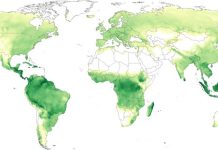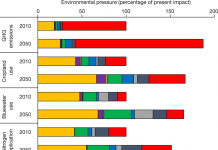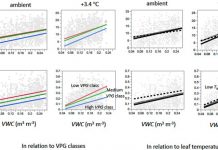【湿热促进氧化亚氮排放】Timothy J. Griffis,Zichong Chen, John M. Bakera,Jeffrey D. Wood, Dylan B. Millet, Xuhui Lee,Rodney T. Venterea, and Peter A. Turner. Nitrous oxide emissions are enhanced in a warmer and wetter world. PNAS, 2017, doi: 10.1073/pnas.1704552114
Abstract
Nitrous oxide (N2O) has a global warming potential that is 300 times that of carbon dioxide on a 100-y timescale, and is of major importance for stratospheric ozone depletion. The climate sensitivity of N2O emissions is poorly known, which makes it difficult to project how changing fertilizer use and climate will impact radiative forcing and the ozone layer. Analysis of 6 y of hourly N2O mixing ratios from a very tall tower within the US Corn Belt—one of the most intensive agricultural regions of the world—combined with inverse modeling, shows large interannual variability in N2O emissions (316 Gg N2O-N⋅y−1 to 585 Gg N2O-N⋅y−1). This implies that the regional emission factor is highly sensitive to climate. In the warmest year and spring (2012) of the observational period, the emission factor was 7.5%, nearly double that of previous reports. Indirect emissions associated with runoff and leaching dominated the interannual variability of total emissions. Under current trends in climate and anthropogenic N use, we project a strong positive feedback to warmer and wetter conditions and unabated growth of regional N2O emissions that will exceed 600 Gg N2O-N⋅y−1, on average, by 2050. This increasing emission trend in the US Corn Belt may represent a harbinger of intensifying N2O emissions from other agricultural regions. Such feedbacks will pose a major challenge to the Paris Agreement, which requires large N2O emission mitigation efforts to achieve its goals.
—————————————————————————————————————————————–
【早期融雪增强了北方春季碳吸收】Jouni Pulliainen, Mika Aurela, Tuomas Laurila, Tuula Aalto, Matias Takala, Miia Salminen, Markku Kulmal, Alan Barr, Martin Heimann, Anders Lindroth, Ari Laaksonen, Chris Derksen, Annikki Mäkelä, Tiina Markkanen, Juha Lemmetyinen, Jouni Susiluoto, Sigrid Dengel, Ivan Mammarella, Juha-Pekka Tuovinen, and Timo Vesala. Early snowmelt significantly enhances boreal springtime carbon uptake. PNAS, 2017, doi: 10.1073/pnas.1707889114
Abstract
We determine the annual timing of spring recovery from space-borne microwave radiometer observations across northern hemisphere boreal evergreen forests for 1979–2014. We find a trend of advanced spring recovery of carbon uptake for this period, with a total average shift of 8.1 d (2.3 d/decade). We use this trend to estimate the corresponding changes in gross primary production (GPP) by applying in situ carbon flux observations. Micrometeorological CO2 measurements at four sites in northern Europe and North America indicate that such an advance in spring recovery would have increased the January–June GPP sum by 29 g⋅C⋅m−2 [8.4 g⋅C⋅m−2 (3.7%)/decade]. We find this sensitivity of the measured springtime GPP to the spring recovery to be in accordance with the corresponding sensitivity derived from simulations with a land ecosystem model coupled to a global circulation model. The model-predicted increase in springtime cumulative GPP was 0.035 Pg/decade [15.5 g⋅C⋅m−2 (6.8%)/decade] for Eurasian forests and 0.017 Pg/decade for forests in North America [9.8 g⋅C⋅m−2 (4.4%)/decade]. This change in the springtime sum of GPP related to the timing of spring snowmelt is quantified here for boreal evergreen forests.
———————————————————————————————————————————————
【根区真菌在磷循环中的作用】Juliana Almario, Ganga Jeena, Jörg Wunder, Gregor Langen, Alga Zuccaro, George Coupland, and Marcel Bucher. Root-associated fungal microbiota of nonmycorrhizal Arabis alpina and its contribution to plant phosphorus nutrition. PNAS, 2017, doi: 10.1073/pnas.1710455114
Abstract
Most land plants live in association with arbuscular mycorrhizal (AM) fungi and rely on this symbiosis to scavenge phosphorus (P) from soil. The ability to establish this partnership has been lost in some plant lineages like the Brassicaceae, which raises the question of what alternative nutrition strategies such plants have to grow in P-impoverished soils. To understand the contribution of plant–microbiota interactions, we studied the root-associated fungal microbiome of Arabis alpina (Brassicaceae) with the hypothesis that some of its components can promote plant P acquisition. Using amplicon sequencing of the fungal internal transcribed spacer 2, we studied the root and rhizosphere fungal communities of A. alpina growing under natural and controlled conditions including low-P soils and identified a set of 15 fungal taxa consistently detected in its roots. This cohort included a Helotiales taxon exhibiting high abundance in roots of wild A. alpina growing in an extremely P-limited soil. Consequently, we isolated and subsequently reintroduced a specimen from this taxon into its native P-poor soil in which it improved plant growth and P uptake. The fungus exhibited mycorrhiza-like traits including colonization of the root endosphere and P transfer to the plant. Genome analysis revealed a link between its endophytic lifestyle and the expansion of its repertoire of carbohydrate-active enzymes. We report the discovery of a plant–fungus interaction facilitating the growth of a nonmycorrhizal plant under native P-limited conditions, thus uncovering a previously underestimated role of root fungal microbiota in P cycling.








